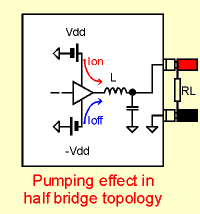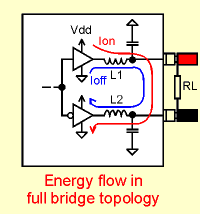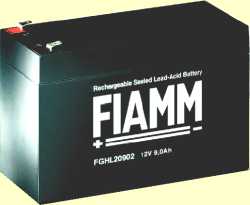In linear amplifiers the energy flow is always from supply to the load, in Class D amplifiers however it is different, as the energy flow can be bi-directional.
A known cause of degradation in Class
D amplifiers is bus pumping, which can be seen
when an amp with half bridge topology is powering a low
frequency output to the load. Always keep in
mind that the gain of a Class D amplifier stage
is directly proportional to the bus voltage. Therefore,
bus fluctuation creates distortion. Since the
energy flowing in the Class D switching stage
is bi-directional, there is a period where the
Class D amplifier feeds energy back to the
power supply. The majority of the energy flowing
back to the supply is from the energy stored
in the inductor of the output low pass filter.
During one switching interval energy is taken from one supply (e.g. Vdd), while a part of that energy is delivered back to the other supply line (e.g. -Vdd) and vice versa. Usually, the power supply has no way to absorb the energy coming back from the load. Consequently the voltage across the power supply capacitors is pumped up, creating bus voltage fluctuations.

Things are quite different if Vdd and -Vdd are batteries. Now each supply is also able to sink current and there is no pumping effect. Another way to avoid bus pumping is to use class D amplifiers with full bridge topology. In this case there is just a single supply and the energy coming back from the load flows to the same power source.

The full bridge topology removes the bus pumping problems at the cost of a greater complexity of the output stage, however as we have noticed, even in this configuration the power supply will observe a bi-directional exchange of energy. That means that the supply voltage will have a ripple noise superimposed it that could degrade the audio signal (let's call it from now on HFN). The amplitude of this ripple voltage is directly proportional to the power supply impedance. Let's now consider other possible sources of power supply noise. The Vdd will have to source the current needed by the load RL, so again there will be an superimposed noise voltage (LFN) proportional to the supply impedance. Finally, the power supply will have a certain amount of intrinsic noise INN due to the nature of the source itself.
In order to minimize the previous noise sources the power supply has to hold a very low impedance. Note that HFN is a high frequency noise (around hundreds of KHz) whereas the LFN bandwidth falls mainly in the audio bandwidth.
Let's now have a look at the typical characteristics of AC mains and battery sources.
AC mains supply
The mains AC voltage (110 .. 240V) is reduced to lower voltages by a transformer. Since all hifi-gear needs direct current, the lowered AC voltage must be rectified. This is done by a couple of diodes which load a capacitor in a switching manner, that means when the capacitor voltage is lower than the transformer voltage the diode is switched on, charging the capacitor. As soon as the voltage across the capacitor reaches the actual level of the transformer secondary voltage, the diode switches off.
The rectification process could introduce noise due to the diodes switching characteristics. Besides that you have to rely on a clean AC mains voltage because the transformer will transfer all the noise components from the mains to the rectifier.
The output impedance of these kind of supply is nothing else that the impedance of the
by-pass capacitor. As the high frequency capacitor impedance is dominated by its Equivalent Series Resistance (ESR), a good power supply has to rely on a low ESR capacitor (or better several paralleled low ESR capacitors). At low frequency, the impedance is strongly influenced by the capacity value C (Z=~ 1/fC) so a low-Z supply will require large capacity values.
Battery power
If we were able to power our hifi-system with a battery, we would not only avoid the mains and diode switching-noise, we would also have a fast power source with a very low impedance. No need to employ large electrolytic capacitors. No need for expensive input filter devices.
Unfortunately, there are also some non-trivial disadvantages associated with batteries. They have a limited life and you have to deal with the recharging issue. Besides, during the listening session, a battery will slowly discharge itself downgrading some of its main characteristics (e.g. its output impedance).
The ROSSO amplifiers power supply
We decided to offer a range of full-bridge amplifiers both with AC mains and battery supplies. AC mains supplies make use of filtered ultra-fast rectifiers and a double-bank capacitors (a bank of large capacitors for taking care of the LF noise and a bank of low ESR capacitors for HF noise). Our battery amplifiers use the most advanced low impedance Sealed Lead-Acid (SLA) batteries. We believe to offer the best accomplishment in each class and left to our customer the power of free choice.
